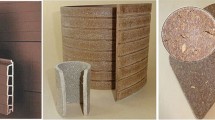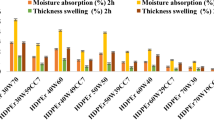Abstract
While extrusion and injection molding are the common technologies to produce wood-plastic composites (WPC), pressing may be an alternative, particularly when flat products are striven for. In this study, flat pressed WPC panels were surface-reinforced by two different types of thermoplastic face layers to improve flexural properties. The two face materials applied were a commingled fabric made of glass and polypropylene filaments (TWINTEX®) and a glass fabric reinforced polypropylene laminate (S-TEX®). Combination of face layers and WPC panels was achieved in a single and a two stage flat pressing process. Besides studying the effects of reinforcing material and number of process stages, the influence on flexural properties of the reinforced panels was identified. Unreinforced WPC panels were tested for comparison. The reinforced WPC panels exhibited greatly improved flexural properties, with MOE (MOR) values up to nearly 10,000 N/mm² (90 N/mm²).
Zusammenfassung
Holz-Kunststoff-Verbundwerkstoffe (wood-plastic composites) (WPC) werden überwiegend im Extrusions- oder Spritzgießverfahren hergestellt. Alternativ hierzu können plattenförmige WPCs mit Hilfe der Flachpresstechnologie hergestellt werden. In dieser Studie wurden flachgepresste WPC-Platten mit zwei verschiedenen thermoplastischen Deckschichtmaterialien verstärkt, um so deren Biegeeigenschaften zu verbessern. Als Deckschichtmaterialien wurden TWINTEX®, eine kombinierte Glasfaser-Polypropylenfaser-Matte, sowie S-TEX®, eine dünne glasfaserverstärkte Polypropylenplatte, verwendet. Die Verbindung zwischen Deckschicht und WPC-Platte wurde in einem ein- und einem zweistufigen Verfahren realisiert. Ergänzend zum Einfluss des Verstärkungsmaterials und der Anzahl der Prozessschritte, wurden die Biegeeigenschaften der verstärkten Platten bestimmt. Als Referenzmaterial dienten unverstärkte WPC-Platten. Durch die Verstärkung der Deckschichten wurde ein Anstieg der Biegeeigenschaften auf einen Wert von fast bist zu 10.000 N/mm2 (MOE) und 90 N/mm2 (MOR) erzielt.







Similar content being viewed by others
References
Albers K, Plath E (1970) Festigkeitseigenschaften beplankter Holzwerkstoffe. Holz-Zent bl 96:41–42
Benthien J T, Thoemen H, Weissmann V, Korte H (2009) WPC-Herstellung nach dem Flachpressverfahren: Einfluss der Rohstoffkomponenten und Herstellungsparameter auf die physikalischen und mechanischen Eigenschaften. 3rd german WPC conference, Cologn, 2–3 Dezember 2009
Benthien JT, Thoemen H (2012) Effects of raw materials and process parameters on the physical and mechanical properties of flat pressed WPC panels. Compos Part A 43(4):570–576
Boeglin N, Triboulot P, Masson D (1997) A feasibility study on boards from wood and plastic waste: bending properties, dimensional stability and recycling of the board. Holz Roh-Werkst 55(1):13–16
Boehme C (1976) Constructive behavior of Gfk-wood sandwiches—comparison of experimental results with various computation, methods. Holz Roh Werkst 34(5):155–161
Cai Z (2006) Selected properties of MDF and flakeboard overlaid with fiberglass mats. Forest Prod J 56(11/12):142–146
Chaharmahali M, Tajvidi M, Kazemi Najafi S (2008) Mechanical properties of wood plastic composite panels made from waste fiberboard and particleboard. Pol Compos 29(6):606–610
Dai HM, Smith MJ, Ramani K (2004) Design and processing of a thermoplastic composite reinforced wood structure. Polym Compos 25(2):119–133
DIN EN 310 (1993) Holzwerkstoffe; Bestimmung des Biege-Elastizitätsmoduls und der Biegefestigkeit
Falk RH, Vos DJ, Cramer SM (1999) The comparative performance of woodfiber-plastic and wood based panels. In: Rowell R (ed) 5th International Conference on Woodfiber-Plastic-Composites, Madison, pp 269–274
Gupta N (2007) Response of syntactic foam core sandwich structured composites to three-point bending. J Sandwich Struct Mate 4(3):249–272
Jiang L, Wolcott MP, Zhang JW et al (2007) Flexural properties of surface reinforced wood/plastic deck board. Polym Eng Sci 47(3):281–288
Philipp K (2005) Flachgepresste Holz-Kunststoff-Verbundwerkstoffe. Diploma Thesis. University of Hamburg, Germany
Rizvi GM, Semeralul H (2008) Glass-fiber-reinforced wood/plastic composites. J Vinyl Add Tech 14(1):39–42
Stark N (2001) Influence of Moisture Absorption on Mechanical Properties of Wood Flour–Polypropylene Composites. J Thermoplast Compos Mater 14(5):421–432
Wolcott MP (2003) Formulation and process development of flat-pressed wood-polyethylene composites. For Prod J 53(9):25–32
Author information
Authors and Affiliations
Corresponding author
Rights and permissions
About this article
Cite this article
Schmidt, H., Benthien, J.T. & Thoemen, H. Processing and flexural properties of surface reinforced flat pressed WPC panels. Eur. J. Wood Prod. 71, 591–597 (2013). https://doi.org/10.1007/s00107-013-0719-y
Received:
Published:
Issue Date:
DOI: https://doi.org/10.1007/s00107-013-0719-y




